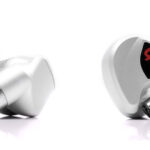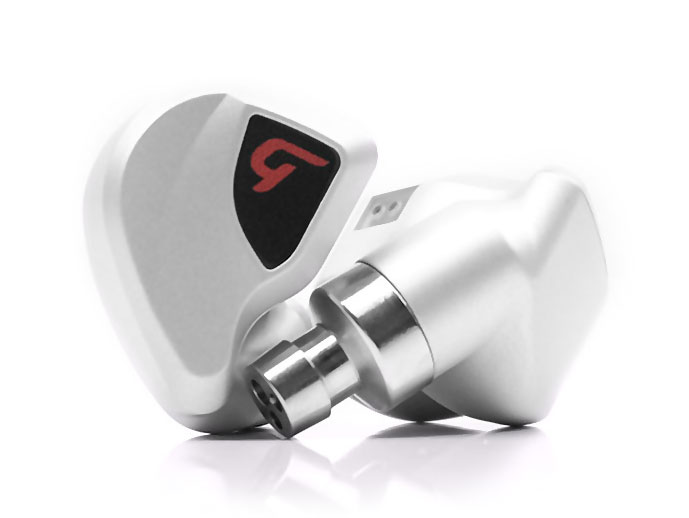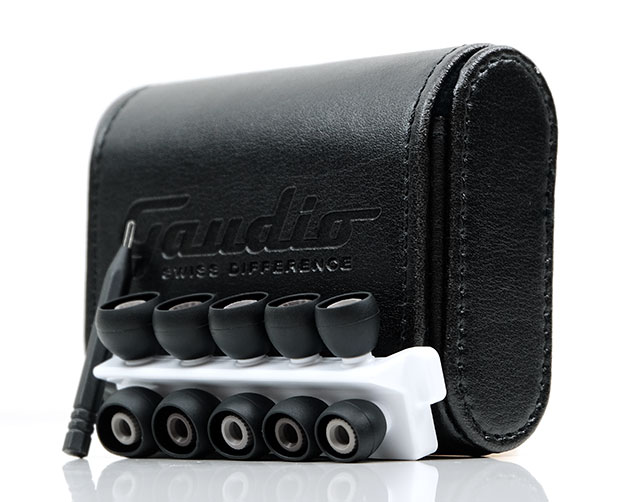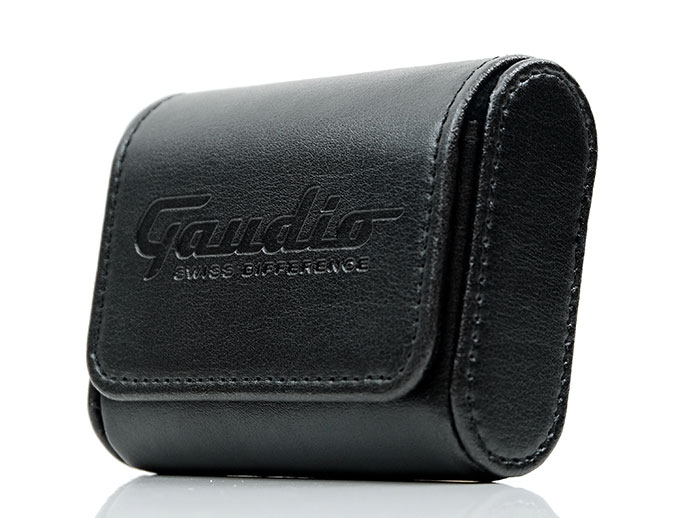The Gaudio Nair & Clariden are a pair of Swiss-Made triple BA IEMs, each with its own unique tuning. They are priced at €759.65 each ex. VAT MSRP.
Disclaimer: The Gaudio Nair & Clariden sent to us for this full review are samples in exchange for our honest opinion. We thank Gaudio for this opportunity.
To learn more about IEMs featured on Headfonics you can click here.
Note, this review follows our new scoring guidelines for 2020 which you can read up on here.
We first highlighted these two creations from Swiss-based Gaudio in late March 2020 and what instantly stuck out in my mind was not just the distinctly different tuning but also the attention to detail.
At the time we only had a basic outline with the drivers in a sample bag along with the carry case. Having now seen the full packaging the brand and positioning of the 2 monitors are also becoming a lot clearer. If you understand how some Swiss Watch brands are sold, the Gaudio & Nair positioning is not that far off, to be honest.
What does that mean? Well, words like attention to detail, engineering precision, and accuracy come to mind. In many ways, that is how I feel about the Clariden and in particular, the Nair.
The following full review is a continuance of the original First Contact of the Gaudio Nair & Clariden and as such, there is a degree of overlap on page 1. For those who wish to get straight to the in-depth sound impressions and select comparisons, you may skip to page 2. For everyone knew to these monitors, read on.
Tech Inside
Having talked with the team I came to the conclusion that there was a lot of in-house work being done by Gaudio in bringing these monitors to the market. These are not simply OEM rebrands with a fresh lick of paint. All the engineering is done in-house and assembled in-house which is why I guess the price is a shade higher but so also the quality control.
Though monitors both have 3 balanced armature driver configurations, there are some slight differences in their specifications. All drivers are sourced and tweaked via established players, Sonion and Knowles.
The Gaudio Nair uses two acoustical paths and is rated at 26Ω whereas the Gaudio Clariden uses 3 acoustical paths and is the easier of the two to drive at 17Ω. I would presume that either a slightly different mix of drivers per monitor is being used or the resistance level is tweaked a little lower to allow for their different sound signatures to come out.
The two monitors do share the same 3-way passive configuration and the same external machining so they operate in a very similar manner.
Design
The cutting or milling on the Gaudio Nair and Gaudio Clariden shells are beautiful with clean lines and a smooth silver anodized finish. The only strong visual difference between the two is the moniker and faceplate accents with the Nair using an enamel color and the Clariden using a black and red motif.
Both monitors are made of CNC Aluminum which is a tricky material to cut to such a fine standard. These are on the same level as something like the Rai Penta from Meze just finished a little differently.
The sizing is on the large but light side using deep stainless-steel nozzles. The main housing will not be touching your ears if the tip choice is used correctly and thankfully the tips supplied are comfy to use. Even if they do end up touching the edging is not sharp at all so they are unlikely to be uncomfortable.
Stock Cable
Both the Gaudio Clariden and the Gaudio Nair come supplied with a Satin Audio Hyperion aftermarket cable. I am a big fan of Satin Audio cables because you get a lot of performance for an affordable price. They are almost always built to a really high standard also.
The Hyperion cable is part of Satin Audio’s Monster Series of cables that also includes the previously reviewed Medusa. This is a 1.2m 28AWG wire using SP-OCC Pure SPC Type 2 Litz geometry, a nylon damping core, and audio grade Cardas Audio Quad Eutectic Solder. Litz means these cables will not oxidize or gradually turn ‘green’. On an off-white creation that would be terrible.
Finishing
The terminations for the Gaudio Nair and Gaudio Clariden are both gold-plated Tellurium Copper (TeCu) 0.78mm 2-pin for the connectors and gold-plated 3.5mm TRS for the jacks.
The cables come with Carbon fiber and gunmetal aluminum alloy for the barrels but the splitter choice is slightly different and does not use Satin Audio’s standard SA silver carbon or black carbon designs. The splitter barrels on the Gaudio supplied cables are the same barrels used for the 2-pin connectors and are a lot lighter than the standard highly damped standard SA options.
There is no memory wire on the Hyperion cables so they do have a slight bit of microphone or physical noise travel above the splitter. The PEEK translucent jacket, however, is very pliant and easy to work with so quite low on kinks and tangles.
Comfort & Isolation
I love the balance Gaudio has achieved with the design of the Nair and Clariden. Since both have the same form factor both there is no difference in their fitting that I can feel in the ear so far.
As mentioned, they seem light for their size but that additional long nozzle works a treat by allowing the tips to do the donkey work for the seal. As a result, they are above average for isolation. Not custom levels of isolation but pretty darn close and will give acrylic custom universal contouring a run for their money.
The stability of the two IEMs in the ear with the stock tips is rock solid. There is no sweet spot hunting and zero movements, even with open jaw movement which can often lead to gaps forming in the seal.
Objectives
I spoke to Gaudio and asked them how this shape was chosen and the reason behind it in relation to the type of fitting they wanted to achieve.
The main concern here was to get the angled canal done right and coupled with the deep insertion it wasn’t an easy task at all, but in the end, I think we succeeded.
To provide a better fit, we drawn it for having a reduced interaction with the intertragus notch, tragus and concha cymba areas; since we wanted it to sit firmly in the ear, we also paid much attention in designing it to achieve a good coupling with the concha cavum area.
Also, due to the form, it’s possible to rotate it for both an easier insertion and better adjustability. People with medium to big ears will have them slip in the ear without problems and stay almost flush to the ear.
People with little ears or particular canal shapes will still be able to wear them, just having to position them a bit more toward the exterior and using the smallest ear-tips provided.
Tips
The tip selection is Final E which I am growing to favor as foam replacements. I initially had issues with them a few years back because of how they could seal shut under pressure and block the sound from entering your ear.
However, practice makes perfect and now I get a great seal with them, almost as good as foam. They are also excellent for low-end performance do not attenuate the highs as foams can.
The tips are saddled in a useful white tips tray which I appreciate. You get 5 sizes, XS, S, M, L, and XL, and generally, I use the largest of the Final E tips to maximize the pressure and enhance the seal as best I can.
One small suggestion if you find the Clariden top-end a little too hot is to roll to a foam tip that can wetten the attack and softer the response. It will such out some of the energy and contrast but does create a more forgiving tone without any loss of low-end impact. For the Nair, the supplied tips feel just right in terms of tonal balance.
Packaging
My samples originally came to me ‘naked’ as in packaged without the official packaging so I did not have too much to work on during our first impressions piece. Now the final product packaging is ready and it is actually quite nice and, well, pretty much how I imagined a Swiss product to look like.
My apologies if that comes across as potentially stereotyping but it is a positive rather than a negative critique. This reminds me of Tissot SA watch packaging a lot which is a high-end Swiss watchmaker who uses a very clean mix of red, black, and white.
Gaudio have augmented this theme with a slightly 50’s classic American retro angular styling and a split flip lid so it does look unique. Inside, the layout is more classic IEM for me but well laid out with plenty of protective foam for the drivers and accessories.
Accessories
The supplied accessory lineup is actually very good in terms of what is included. It is not a huge line-up but what is included is tastefully done.
The cable is sourced from Satin Audio, their Hyperion from their Titan Series of cables which is a good aftermarket cable.
The final inclusions are a leather flip case branded with Gaudio and a cleaning brush. I have seen this case many times before in packaging of all shapes and price points from SIMGOT up to DUNU so it is not unique. However, this one seems good quality and quite malleable in the leather quality.
Click on Page 2 below for Sound Impressions & Comparisons








